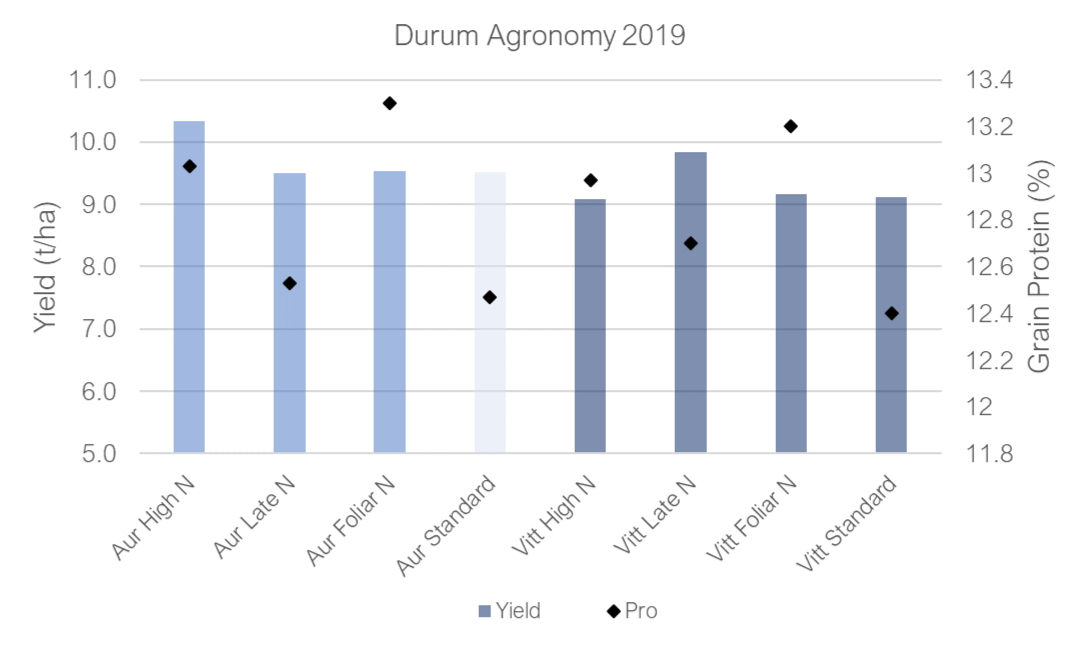Agronomy Trials
In 2020 ICC is collaborating with FAR Australia on the GRDC funded Project “Development and validation of soil amelioration and agronomic practices to realise the genetic potential of grain crops grown under a high yield potential, irrigated environment in the northern and southern regions” includes 66 replicated field trials per year for 3 years. It covers the major irrigation types distributed across the Murrumbidgee and Murray Valleys of southern NSW, the Murray Valley of northern Victoria, south-east SA, SA/Vic Mallee and Tasmania.
2019 – Durum Wheat Agronomy Trial Results
Durum wheat has offered a premium over bread wheat at times in the past. However high yields requires relatively high N inputs to ensure the minimum 13% grain protein is met. The ICC have been investigating strategies to minimise the risk of committing the inputs to a durum crop and failing to meet DR1 requirements.
Our strategy is as follows:
Sown after a faba bean crop so as to utilise the N fixed by the fabas
- Assuming the N requirement is 50 kg N/ha
- Delaying sowing until at least the third week of May.
- Topdressing weighted towards the later part of the season.
The way we address the difference between the nitrogen we have (soil N pre-sowing plus the estimated mineralisation) and the crop demand has been the subject of trials over the past few seasons. The key is to get the yield prediction right and so supply the crop with adequate N in crop through various topdressing strategies.
Objective
Evaluate two durum varieties for yield potential and grain quality under various N topdressing strategies.
Results
Two durum wheat varieties were sown on May 22nd and harvested on November 29th. Average yield was 9.5 t/ha, with DBA Aurora and DBA Vittaroi having similar yields.
Grain protein was almost identical, averaging 12.8%, and statistical analysis showed no treatment effects leading to higher grain protein. N budgets were calculated using 50 kg N/t and a yield target of 8 t/ha. Exceeding the yield target resulted in grain protein of slightly below DR1 specifications of 13%.
The trial averaged 9.51 t/ha, with DBA Aurora averaging 9.72 t/ha and DBA Vittaroi 9.30 t/ha. When all yield data is analysed, no treatment resulted in a statistically valid yield difference (p=0.239). If the yields are analysed by variety, there was no difference in treatment yields when applied to Aurora, but there was a slight improvement with the ‘late N’ treatment (p=0.044, lsd = 0.54 t/ha) in Vittaroi over the standard treatment.
Wheat Agronomy Trial Results
Objectives
Results
While the ‘early’ treatment resulted in slightly higher dry matter yields, these were not statistically significant. Keep in mind these are not hay yields as the samples were cut at ground level and are dried down to 0% moisture. Similarly, there was no difference in grain yield or grain protein.
Harvest index (the ratio between grain and total biomass) was poor. Wheat typically has a harvest index of 0.4 (eg a 4 t/ha grain crop would have a total biomass of 10 t/ha), but in this trial the average was approximately 0.3 for both treatments. As a comparison, the 2018 harvest survey of 24 irrigated crops saw an average of 0.39. Grain crops can have a low harvest index due to frost, poor grain fill or grain shedding, but neither were observed in the trial.
Gross margin analysis of the trial suggests hay would have been the more profitable option and had a positive gross margin even with high water price scenarios.




